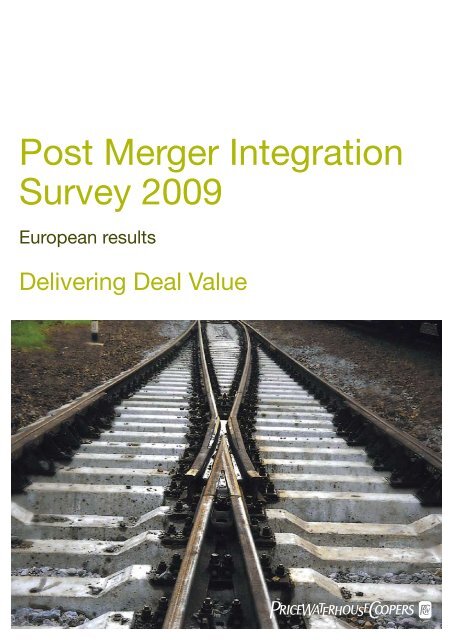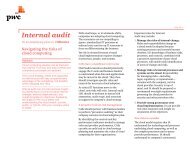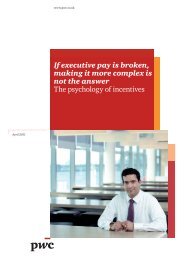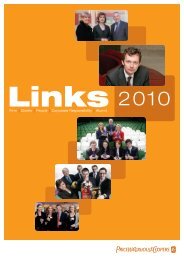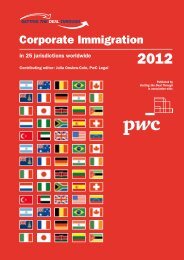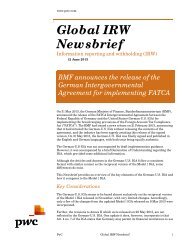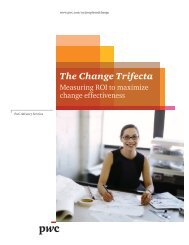Post Merger Integration Survey 2009 - PwC
Post Merger Integration Survey 2009 - PwC
Post Merger Integration Survey 2009 - PwC
You also want an ePaper? Increase the reach of your titles
YUMPU automatically turns print PDFs into web optimized ePapers that Google loves.
<strong>Post</strong> <strong>Merger</strong> <strong>Integration</strong><br />
<strong>Survey</strong> <strong>2009</strong><br />
European results<br />
Delivering Deal Value<br />
<strong>Post</strong> <strong>Merger</strong> <strong>Integration</strong> <strong>Survey</strong> <strong>2009</strong><br />
1
Contents<br />
Introduction 2<br />
Executive Summary 3<br />
Key findings 4<br />
Results in detail 8<br />
Appendices<br />
1. Participant profiles 20<br />
2. Key contacts 21<br />
List of figures<br />
Figure 1: Strategic objectives of transactions 10<br />
Figure 2: Financial objectives of transactions 10<br />
Figure 3: Due diligence execution 11<br />
Figure 4: Achievement of synergy and performance targets 12<br />
Figure 5: Overrun of planned integration costs 12<br />
Figure 6: When companies started to plan their integration activities 13<br />
Figure 7: Achievement rates of objectives 13<br />
Figure 8: Measurement of financial and strategic goals 14<br />
Figure 9: Frequency of measuring financial and strategic goals 14<br />
Figure 10: Actual level of involvement during the integration 15<br />
Figure 11: Ideal level of involvement during the integration 15<br />
Figure 12: Extent integration success is linked to compensation schemes 16<br />
Figure 13: Successful communication of integration goals 17<br />
Figure 14: Evaluation of integration pace in retrospect 18<br />
Figure 15: Main challenges in the integration 19<br />
Figure 16: Participant profiles, country 20<br />
Figure 17: Participant profiles, industry 20<br />
<strong>Post</strong> <strong>Merger</strong> <strong>Integration</strong> <strong>Survey</strong> <strong>2009</strong><br />
1
Introduction<br />
Contracts are signed, the purchase price is paid, the employees,<br />
other stakeholders and public are informed – now what? Every<br />
year the same question is asked by companies who have<br />
embarked on the adventure of an acquisition.<br />
Acquisitions often have a significant impact on the business. Management should<br />
therefore be closely involved in all phases of the acquisition, pre deal, during the<br />
execution and post deal. After all, sustainable value creation is not achieved by<br />
closing the transaction, but by conducting successful joint businesses afterwards.<br />
With this study, we want to give you an understanding of critical success factors<br />
of transactions and do’s and don’ts in the approaches to transactions. To learn<br />
and benefit from the experiences of other companies integration projects is time<br />
well spent.<br />
Our findings mostly reflect the positive macroeconomic environment in Europe up<br />
until mid 2008. The economic downturn is going to influence the entrepreneurial<br />
context of transactions and post merger integration activities. We believe that future<br />
transactions will be even more focused on value creation. Management’s attention<br />
will be turned primarily to the organisation and structure of the acquired company<br />
and the potential to grow the joint business in the current market conditions.<br />
We wish you a pleasant and insightful read.<br />
Chris Meijnders<br />
Dr. Ralf C. Schlaepfer<br />
Partner Transaction Services<br />
Partner Head Consulting<br />
PricewaterhouseCoopers Advisory N.V. PricewaterhouseCoopers Ltd.<br />
Rotterdam<br />
Zurich<br />
+31 (0)10 407 65 47 +41 58 792 16 20<br />
chris.meijnders@nl.pwc.com<br />
ralf.schlaepfer@ch.pwc.com<br />
2<br />
PricewaterhouseCoopers
Executive summary<br />
The findings of the survey reflect the economic environment<br />
during the past three years. Most of the acquisitions were<br />
primarily intended to create top line growth, by capturing new<br />
regions, new customers or new products.<br />
The distinctive phases of a transaction (initiation, due diligence and integration)<br />
are often assigned to separate areas of responsibility and therefore contain the risk<br />
of information loss at interfaces, for example the due diligence findings are only<br />
used infrequently during integration planning.<br />
Although often analysed and published, areas such as communication, change<br />
management and the handling of (managerial) employees, remain challenging<br />
during integration. If these ‘soft issues’ are ignored, they can easily impact<br />
‘hard numbers’.<br />
The current macroeconomic trend of declining demand has impacted M&A<br />
activities severely. Firstly, the number of mergers and acquisitions decreased<br />
significantly. Secondly, the focus of transactions is shifting from growth to<br />
efficiency, hence future integration projects will have strong consolidation and<br />
restructuring components.<br />
We believe that in the current economic downturn, post merger projects will tend to<br />
focus more on the following issues:<br />
• “Value enhancement” instead of increased company growth<br />
• Robust and well controlled transition from the due diligence phase to the<br />
integration, ensuring that all relevant due diligence findings are captured and<br />
addressed<br />
• Rapid transformation with regard to change management issues and efficient<br />
communication<br />
This study is a compilation of post merger integration surveys conducted by <strong>PwC</strong><br />
in eight European countries with more than 250 top executives, who were part of<br />
post merger integration projects during the past three years. These executives<br />
belonged either to the acquirer or to the target company. The surveys took place<br />
during the first part of <strong>2009</strong>. Detailed information about the participating companies<br />
is included in the appendix.<br />
<strong>Post</strong> <strong>Merger</strong> <strong>Integration</strong> <strong>Survey</strong> <strong>2009</strong><br />
3
Section 1<br />
Key findings<br />
4 PricewaterhouseCoopers
<strong>Post</strong> <strong>Merger</strong> <strong>Integration</strong> <strong>Survey</strong> <strong>2009</strong><br />
5
Key highlights<br />
1<br />
2<br />
The primary transaction<br />
objective is growth<br />
Due diligence has become<br />
standard<br />
The majority of the respondents<br />
consider a strengthened market<br />
share and (cost) synergy goals to be<br />
the most important objectives of a<br />
transaction.<br />
In 81% of all transactions,<br />
companies carried out some form<br />
of due diligence. The relevance of<br />
the diligence findings post deal can<br />
be improved by focusing more on<br />
operational and commercial aspects<br />
pre deal.<br />
6<br />
7<br />
Early involvement of<br />
the integration team<br />
is key to success<br />
<strong>Integration</strong> objectives<br />
not part of remuneration<br />
schemes<br />
A majority of Boards is involved in<br />
the acquisition pre deal, but that<br />
percentage drops once the deal<br />
has been closed. For the integration<br />
team, it is the reverse and ideally,<br />
executives would like to see this<br />
involvement increase, especially pre<br />
closing.<br />
Successful communication of<br />
integration goals to the stakeholders<br />
such as employees, customers,<br />
suppliers and vendors is key and<br />
currently lacks quality.<br />
6 PricewaterhouseCoopers
3<br />
Transactions are<br />
considered successful.<br />
However, integration<br />
costs are underestimated<br />
4<br />
Early planning of<br />
integration is critical<br />
5<br />
Most companies closely<br />
monitor integration progress<br />
The majority of respondents view<br />
their transaction as successful based<br />
on the achievement of synergy and<br />
performance targets. However, the<br />
budgets of integration projects are<br />
often extensively exceeded.<br />
Planning the post merger integration<br />
phase prior to deal closure helps to<br />
better achieve cost synergies and<br />
timely access to new products and<br />
markets.<br />
More than 70% of the companies<br />
measure integration success<br />
systematically by means of KPI<br />
reporting and following-up financial<br />
effects of the integration activities.<br />
8<br />
9<br />
10<br />
Communication needs<br />
to improve, especially<br />
during first 100 days<br />
Speed is critical<br />
Challenges around the<br />
human element are still key<br />
More than three quarters of the<br />
respondents indicated that the<br />
compensation scheme of the<br />
integration leader is not linked to the<br />
integration goals.<br />
In retrospect, more than 60% of<br />
the executives argue that a faster<br />
integration would have delivered<br />
more cost savings and would have<br />
reduced uncertainty.<br />
Alignment of the organisation and<br />
alignment of processes are seen as<br />
the toughest post-deal challenges,<br />
closely followed by the alignment of<br />
different cultures.<br />
<strong>Post</strong> <strong>Merger</strong> <strong>Integration</strong> <strong>Survey</strong> <strong>2009</strong><br />
7
Section 2<br />
Results in detail<br />
8 PricewaterhouseCoopers
<strong>Post</strong> <strong>Merger</strong> <strong>Integration</strong> <strong>Survey</strong> <strong>2009</strong> 9
The primary transaction objective is<br />
growth, followed by margin improvement<br />
<strong>PwC</strong> view<br />
These objectives reflect the positive<br />
economic environment of the three<br />
years to mid-2008. Companies<br />
typically were more focused<br />
on sales growth, rather than on<br />
profitability improvement. Due to<br />
the economic downturn, emphasis<br />
will switch to cost issues and<br />
future deals will have a stronger<br />
focus on margins and profitability<br />
improvement.<br />
Growth related objectives are the most important drivers for acquisitions.<br />
Figure 1: Strategic objectives of transactions<br />
100%<br />
80%<br />
58%<br />
60%<br />
40%<br />
37%<br />
33%<br />
23%<br />
19%<br />
20%<br />
0%<br />
Growth in<br />
market share<br />
Achievement of<br />
cost synergies<br />
Access to new<br />
geographical<br />
markets<br />
Access to new<br />
products<br />
Reduction in<br />
number of<br />
competitors<br />
The strategic objectives are reflected in the financial objectives where sales growth<br />
is the dominating KPI.<br />
Figure 2: Financial objectives of transactions<br />
100%<br />
80%<br />
60%<br />
40%<br />
42%<br />
35%<br />
31%<br />
20%<br />
20%<br />
19%<br />
0%<br />
Revenue growth<br />
goals<br />
Overall synergy<br />
goals<br />
EBIT<br />
goals<br />
Return on inested<br />
capital goals<br />
Return on equity<br />
goals<br />
10 PricewaterhouseCoopers
Due diligence (DD) has become standard –<br />
DD findings are important for making acquisition<br />
decisions and integration planning<br />
DD is conducted prior to almost every transaction. In most cases however,<br />
the various areas of DD are performed separately, rather than as an integrated<br />
Business DD approach. Almost all areas of DD have an impact on the purchase<br />
decision. Classic financial DD and analysis of the market and competitive<br />
conditions (Commercial DD) are rated as top priorities.<br />
Figure 3: Due diligence execution<br />
100%<br />
80%<br />
60%<br />
40%<br />
19%<br />
81%<br />
No due<br />
diligence<br />
Due<br />
diligence<br />
Finance<br />
Tax<br />
Commercial<br />
HR<br />
IT<br />
Pensions<br />
<strong>PwC</strong> view<br />
The understanding of the<br />
transaction as an overall process,<br />
beginning at the M&A phase<br />
and ending with the completed<br />
integration, is not yet common<br />
place. A certain degree of staff<br />
consistency for example, would<br />
bring more continuity to the<br />
overall process. Particularly<br />
the identification (pre deal), the<br />
validation (in DD) and the realisation<br />
of synergies (post deal) should fall<br />
into the same area of responsibility.<br />
20%<br />
Environmental<br />
0%<br />
Legal<br />
0% 20%<br />
40%<br />
60% 80%<br />
100%<br />
The results show that companies focus the DD on financial aspects and pay less<br />
attention to operational issues. However, when asked what could be improved in<br />
the integration process, many participants mentioned improving the quality of the<br />
DD process by intensifying the operational and commercial efforts.<br />
“Greater rigour is required<br />
in future due diligence as<br />
a number of difficulties/<br />
additional costs arose on<br />
this acquisition as a result<br />
of gaps in due diligence.”<br />
“More thorough IT due<br />
diligence.<br />
Focus on synergies,<br />
customers & markets”<br />
<strong>Survey</strong> participants<br />
<strong>Post</strong> <strong>Merger</strong> <strong>Integration</strong> <strong>Survey</strong> <strong>2009</strong><br />
11
Overall, transactions are considered<br />
successful. However, the costs to achieve<br />
integration are underestimated<br />
<strong>PwC</strong> view<br />
In the current economic climate,<br />
efforts to realise potential synergies<br />
will gain in importance. The<br />
systematic evaluation, planning and<br />
execution of potential synergies<br />
during the integration phase<br />
can reduce costs of the merged<br />
entities and therefore enhance the<br />
enterprise value.<br />
The realisation of synergies and performance targets is high - over 80%. The result<br />
is much higher than in previous <strong>PwC</strong> studies, which indicates that companies are<br />
taking transaction preparation and integration issues more seriously.<br />
Figure 4: Achievement of synergy and performance targets<br />
No targets set<br />
6%<br />
Failed to meet targets<br />
13%<br />
66% Met set targets<br />
Exceeded set targets<br />
15%<br />
In addition to the costs, the time to<br />
implement is often underestimated<br />
as well, potentially resulting in an<br />
uncontrolled use of resources.<br />
This often leads to overburdened<br />
employees or the disregard of daily<br />
business. The accurate planning<br />
of internal costs is essential for an<br />
integration project.<br />
To achieve the integration targets, over one third of the participants reported an<br />
overrun on the planned integration costs.<br />
Figure 5: Overrun of planned integration costs<br />
Yes 39%<br />
61% No<br />
12 PricewaterhouseCoopers
Early planning of integration<br />
activities is critical<br />
A third of the companies surveyed started planning their integration activities after<br />
closing the deal, leaving them little time for a structured and elaborated approach.<br />
Figure 6: When companies started to plan their integration<br />
activities<br />
<strong>PwC</strong> view<br />
This is a missed opportunity as<br />
the results show that planning the<br />
post deal integration phase prior to<br />
the deal’s closure helps to better<br />
achieve the acquisition objectives.<br />
Starting early does not only provide<br />
more time, but more importantly,<br />
more options.<br />
After closing 31%<br />
69% Prior to closing<br />
Figure 7: Achievement rates of objectives,<br />
based on full achievement<br />
100%<br />
80%<br />
60%<br />
21%<br />
14%<br />
27% 27%<br />
26%<br />
“Start way earlier with a<br />
good plan of what I want to<br />
achieve”<br />
“Define integration strategy<br />
and team > 3 months prior<br />
to closing”<br />
40%<br />
58%<br />
23%<br />
37% 33%<br />
19%<br />
<strong>Survey</strong> participants<br />
20%<br />
0%<br />
Achievement of<br />
cost synergies<br />
Enlarge market<br />
share<br />
Revenue gorwth<br />
goals<br />
Access to new<br />
products<br />
Access to new<br />
geographical<br />
markets<br />
Companies that started planning their post deal integration activities before closing the deal<br />
Companies that started planning their post deal integration activities after closing the deal<br />
<strong>Post</strong> <strong>Merger</strong> <strong>Integration</strong> <strong>Survey</strong> <strong>2009</strong><br />
13
Most companies closely monitor the<br />
integration progress<br />
<strong>PwC</strong> view<br />
84% of the respondents continuously monitor the process of financial integration<br />
goals. Most of the companies (72%) also measure progress of the strategic targets.<br />
Monthly review appears to be<br />
the most common frequency of<br />
financial and strategic performance<br />
measurements. However, more<br />
attention is given to measuring<br />
financial goals, most likely due<br />
to the convenience of measuring<br />
quantitative data.<br />
Figure 8: Measurement of financial and strategic goals<br />
Financial goals 84%<br />
16%<br />
Strategic goals<br />
72%<br />
28%<br />
0% 20%<br />
40%<br />
60% 80%<br />
100%<br />
Yes<br />
No<br />
Considering that strategic goals tend to be more long term, the popularity of<br />
performing quarterly reviews may be a rationale behind this.<br />
Figure 9: Frequency of measuring financial and strategic goals<br />
Financial goals 9% 57% 25%<br />
4%<br />
2%<br />
3%<br />
Strategic goals<br />
9%<br />
40% 34%<br />
5%<br />
6%<br />
7%<br />
0% 20%<br />
40%<br />
60% 80%<br />
100%<br />
Weekly Monthly Quarterly Yearly<br />
Only once at the end of the integration Not regularly<br />
14 PricewaterhouseCoopers
Early involvement of the integration<br />
team is key to success<br />
Given the strategic importance of acquisitions, it is not surprising that the majority<br />
of Boards (67%) is involved before closing the deal. However, once the deal is<br />
closed, the involvement of Boards drops to approximately 59%. In 35% of the<br />
cases, the integration team is not or hardly involved in the planning process before<br />
closing the deal. Their involvement increases post closing, but still not to the levels<br />
of full involvement.<br />
Figure 10: Actual level of involvement during integration (medium/high)<br />
100%<br />
80%<br />
60%<br />
Board<br />
<strong>Integration</strong> team<br />
Advisors<br />
67% 65%<br />
58% 59%<br />
79%<br />
40%<br />
35%<br />
20%<br />
0%<br />
Before closing<br />
After closing<br />
Board level involvement is more or less at par with what participants would like<br />
in an ideal situation. However, the involvement of the integration team (especially<br />
pre deal) should be higher. Participants would also like a higher involvement of<br />
advisors.<br />
Figure 11: Ideal level of involvement during integration (medium/high)<br />
100%<br />
80%<br />
60%<br />
Board<br />
<strong>Integration</strong> team<br />
Advisors<br />
62%<br />
82%<br />
68%<br />
55%<br />
98%<br />
45%<br />
<strong>PwC</strong> view<br />
Management attention is critical in<br />
ensuring (integration) targets are<br />
reached, before closing the deal<br />
and during the integration period.<br />
40%<br />
20%<br />
0%<br />
Before closing<br />
After closing<br />
<strong>Post</strong> <strong>Merger</strong> <strong>Integration</strong> <strong>Survey</strong> <strong>2009</strong><br />
15
<strong>Integration</strong> objectives are not part of<br />
remuneration schemes<br />
<strong>PwC</strong> view<br />
In general, a strong link between<br />
the incentives and the integration<br />
goals will ensure a higher degree of<br />
success. Linking the compensation<br />
schemes of the integration leader<br />
and the integration team to the<br />
integration goals is advised<br />
if (i) the leader and team can<br />
have an effective impact on the<br />
achievement of the integration<br />
goals and (ii) if these achievements<br />
are measurable.<br />
In a vast majority of the cases, respondents indicated that the compensation<br />
scheme of the management team and integration leader/integration team is not<br />
linked to the integration goals.<br />
Figure 12: Extent integration success is linked to the<br />
compensation schemes<br />
100%<br />
80%<br />
60%<br />
40%<br />
20%<br />
16%<br />
33%<br />
28%<br />
32%<br />
24%<br />
20%<br />
0%<br />
Board CEO CFO/<br />
Head M&A/<br />
Division<br />
lead<br />
<strong>Integration</strong><br />
leader<br />
<strong>Integration</strong><br />
team<br />
“More involvement and dedication of the integration team,<br />
instead of them seeing it as an job on the side”<br />
<strong>Survey</strong> participants<br />
16 PricewaterhouseCoopers
Successful communication of integration goals should<br />
include all stakeholders and focus on first 100 days<br />
Communication of integration objectives before closing and during the first 100<br />
days is mainly focused on the Board and on management.<br />
The communication to other stakeholders equally important to the day to day<br />
operations – employees, customers, suppliers and vendors – lacks quality.<br />
Particularly the drop during the first 100 days – a time of great change and<br />
uncertainty – stands out.<br />
Figure 13: Successful communication of integration goals<br />
Analysts/<br />
shareholders/public<br />
Customer/<br />
supplier/vendor<br />
Employees<br />
Board/<br />
management<br />
18%<br />
30%<br />
30%<br />
42%<br />
38%<br />
38%<br />
38%<br />
43%<br />
41%<br />
53%<br />
67%<br />
65%<br />
<strong>PwC</strong> view<br />
During periods of change, clear and<br />
transparent communication is key.<br />
Therefore a clear communication<br />
plan should be established which<br />
allows for interaction and feedback<br />
and is flexible to change. Regular<br />
and frequent communication is<br />
critical in the first 100 days in<br />
reducing uncertainty and retaining<br />
key stakeholders and should not<br />
neglected thereafter.<br />
0% 20%<br />
40%<br />
60% 80%<br />
100%<br />
Before closing 100 days After 100 days<br />
“Communicate more open, find out the hidden frustration!”<br />
“More focus on the employee’s feelings and simplify<br />
communication”<br />
<strong>Survey</strong> participants<br />
<strong>Post</strong> <strong>Merger</strong> <strong>Integration</strong> <strong>Survey</strong> <strong>2009</strong><br />
17
Speed is critical<br />
<strong>PwC</strong> view<br />
Due to the changes and the<br />
additional workload connected to<br />
mergers, the involved employees<br />
often perceive the integration<br />
process as a burden. A fast and<br />
transparent integration can help<br />
minimize employees’ concerns and<br />
ensure continuous loyalty to the<br />
firm. Additionally, it enables a more<br />
rapid return to day-to-day work.<br />
More than 60% of respondents thought that the integration took too long. Reasons<br />
for wanting a faster integration are the potential cost savings, realising synergies<br />
sooner and the reduction of employee uncertainty.<br />
The respondents who preferred a slower integration explained that this was mainly<br />
due to the complexity of the IT integration as well as by delaying non-critical<br />
integration processes.<br />
Figure 14: Evaluation of integration pace in retrospect<br />
Integrate more slowly 38%<br />
62% Integrate more quickly<br />
“Uncertainty paralyses – always!”<br />
“Well-defined structures must be established as soon as possible”<br />
“We would have been able to implement the right ERP system<br />
rather than the suboptimal one we were forced to go with”<br />
“Improved prioritisation of integration activities. Certain integration<br />
projects could be executed 6 to 12 months later”<br />
<strong>Survey</strong> participants<br />
18 PricewaterhouseCoopers
Alignment of the organisation and alignment of processes<br />
are seen as the toughest post-deal challenges, closely<br />
followed by the alignment of different cultures<br />
An increasing process orientation and the continuing importance of information<br />
systems in many companies have shifted the focus in the integration phase<br />
towards processes and IT. They rank as the #1 and #4 challenge in managing the<br />
integration.<br />
Challenges around the human element, such as alignment of different cultures and<br />
motivation of employees are also seen as major challenges for the integration.<br />
Figure 15: Top five challenges in the integration<br />
100%<br />
80%<br />
60%<br />
51% 50%<br />
47%<br />
46%<br />
40%<br />
34%<br />
20%<br />
0%<br />
Alignment of<br />
processes<br />
Alignment of<br />
organisation<br />
Alignment of<br />
different cultures<br />
Alignment of<br />
information<br />
systems<br />
Motivation of<br />
employees<br />
When asked what they would do differently if participants could repeat the<br />
integration, the top three answers were: a more detailed integration planning<br />
upfront, a shorter integration process and improved communications. Additional<br />
answers were: involve a dedicated integration team earlier in the process, improve<br />
quality of integrated business due diligence and more attention for cultural<br />
differences.<br />
“We should have made a clearer choice for one IT infrastructure<br />
and one set of administrative processes, rather than trying the<br />
best of both worlds solution.”<br />
“More attention for communication, provide clarity to all involved”<br />
<strong>Survey</strong> participants<br />
<strong>Post</strong> <strong>Merger</strong> <strong>Integration</strong> <strong>Survey</strong> <strong>2009</strong><br />
19
Appendix 1<br />
Participants profiles<br />
This report is a compilation of different post merger integration surveys sent out in<br />
the following countries:<br />
Figure 16: Country of survey participants<br />
Switzerland<br />
Norway 1%<br />
20%<br />
Belgium<br />
9%<br />
Denmark<br />
8%<br />
2% France<br />
16%<br />
Germany<br />
42%<br />
Netherlands<br />
2%<br />
Italy<br />
This report shows the overall results of the combined surveys. The surveys were<br />
sent out during the first months of <strong>2009</strong>.<br />
Figure 17: Industry of survey participants<br />
Construction and real estate<br />
6%<br />
Business services<br />
8%<br />
Public sector<br />
3%<br />
Financial services<br />
8%<br />
56%<br />
Industrial products<br />
Telecom, IT and entertainment<br />
16%<br />
3%<br />
Energy, utilities and mining<br />
20 PricewaterhouseCoopers
Appendix 2<br />
Key contacts<br />
Belgium<br />
Lieven Adams<br />
Transactions Services<br />
Woluwedal 18<br />
B-1932 Sint-Stevens-Woluwe<br />
Phone: +32 2 7109642<br />
lieven.adams@be.pwc.com<br />
Timothy Buysse<br />
Performance Improvement Consulting<br />
Woluwedal 18<br />
B-1932 Sint-Stevens-Woluwe<br />
Phone: +32 2 7109642<br />
timothy.buysse@be.pwc.com<br />
Denmark<br />
Jens Søndergaard<br />
Delivering Deal Value<br />
Strandvejen 44<br />
DK-2900 Hellerup<br />
Phone:+ 45 3945 9955<br />
jsd@pwc.dk<br />
René Gjerding<br />
Transaction Services<br />
Jens Chr. Skous Vej 1<br />
DK - 8000 Århus C<br />
Phone: +45 8932 5667<br />
rgi@pwc.dk<br />
France<br />
Philippe Loiselet<br />
Global Delivering Deal Value<br />
Crystal Park, 63 rue de Villiers<br />
92208 Neuilly-sur-Seine Cedex<br />
Phone: +33 1 5657 5941<br />
philippe.loiselet@fr.pwc.com<br />
Germany<br />
Christian Knechtel<br />
Global Delivering Deal Value<br />
Marie-Curie-Strasse 24-28<br />
60439 Frankfurt<br />
Phone: +49 69 9585 3188<br />
christian.knechtel@de.pwc.com<br />
Italy<br />
Raffaele Cestari<br />
Delivering Deal Value<br />
Via Monte Rosa 91<br />
20149 Milano<br />
Phone: +39 02 66720530<br />
raffaele.cestari@it.pwc.com<br />
Netherlands<br />
Chris Meijnders<br />
Global Delivering Deal Value<br />
Fascinatio Boulevard 350<br />
3065 WB Rotterdam<br />
Phone:+31 10 407 6547<br />
chris.meijnders@nl.pwc.com<br />
Annemieke Hoekstra<br />
<strong>Post</strong> <strong>Merger</strong> <strong>Integration</strong><br />
De Entree 201<br />
1101 HG Amsterdam Zuidoost<br />
Phone: +31 20 568 7117<br />
annemieke.hoekstra@nl.pwc.com<br />
Norway<br />
Thorbjørn Grindhaug<br />
Delivering Deal Value<br />
Dronning Eufemiasgate 8<br />
0191 Oslo<br />
Phone: +47 95 26 05 10<br />
thorbjorn.grindhaug@no.pwc.com<br />
Switzerland<br />
Dr. Ralf C. Schlaepfer<br />
Global Delivering Deal Value<br />
Birchstrasse 160<br />
<strong>Post</strong>fach, 8050 Zürich<br />
Phone: +41 58 792 1620<br />
ralf.schlaepfer@ch.pwc.com<br />
Gustav Baldinger<br />
Global Delivering Deal Value<br />
Birchstrasse 160<br />
<strong>Post</strong>fach, 8050 Zürich<br />
Phone: +41 58 792 1613<br />
gustav.baldinger@ch.pwc.com<br />
<strong>Post</strong> <strong>Merger</strong> <strong>Integration</strong> <strong>Survey</strong> <strong>2009</strong><br />
21
www.pwc.com<br />
© <strong>2009</strong> PricewaterhouseCoopers LLP. All rights reserved. “PricewaterhouseCoopers” and “<strong>PwC</strong>” refer to the network of member firms of<br />
PricewaterhouseCoopers International Limited (<strong>PwC</strong>IL). Each member firm is a separate legal entity and does not act as agent of <strong>PwC</strong>IL or any other member<br />
firm. <strong>PwC</strong>IL does not provide any services to clients. <strong>PwC</strong>IL is not responsible or liable for the acts or omissions of any of its member firms nor can it control the<br />
exercise of their professional judgment or bind them in any way. No member firm is responsible or liable for the acts or omissions of any other member firm nor<br />
can it control the exercise of another member firm’s professional judgment or bind another member firm or <strong>PwC</strong>IL in any way.<br />
HB 05498


